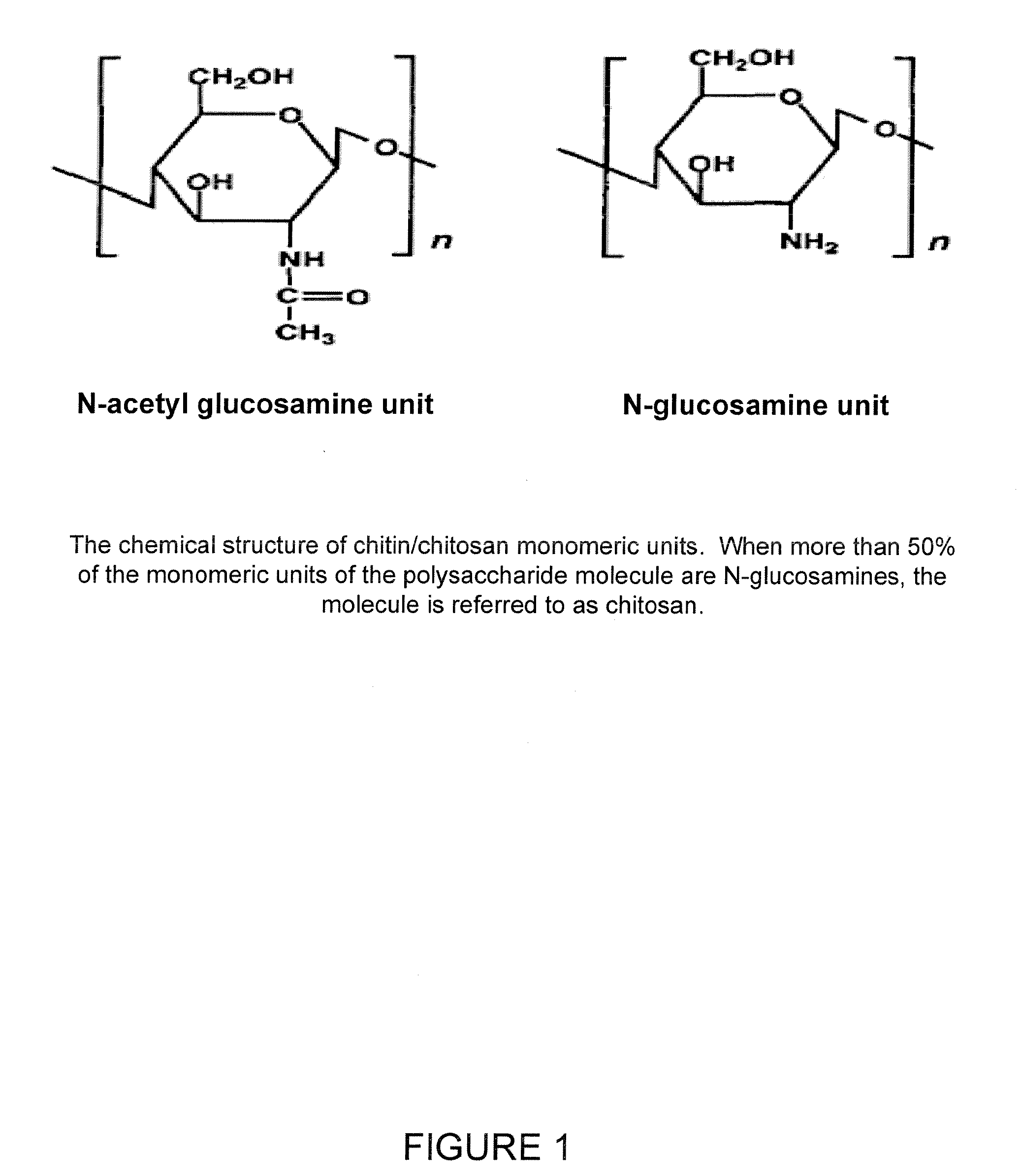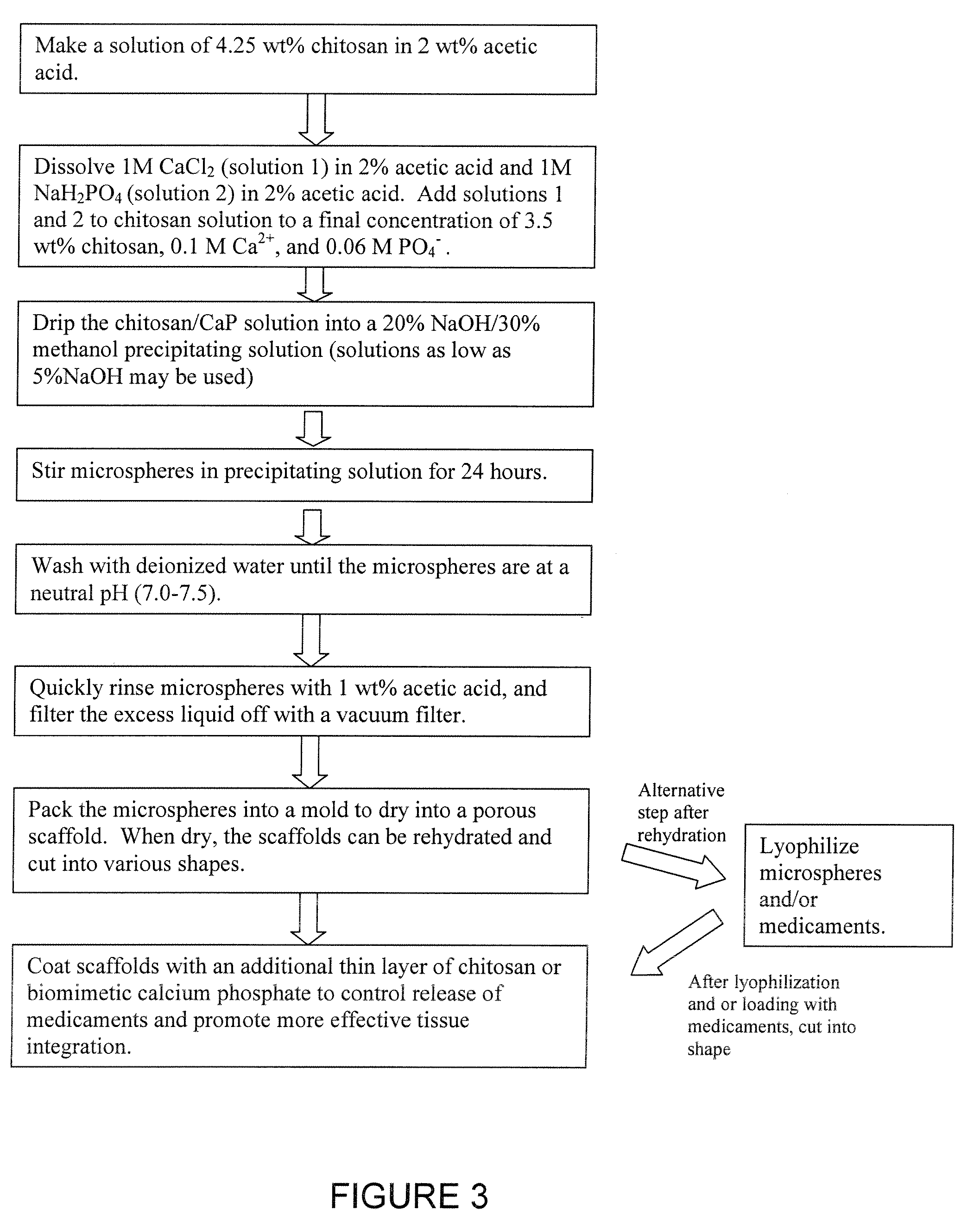Chitosan/nanocrystalline hydroxyapatite composite microsphere-based scaffolds
a technology of hydroxyapatite and chitosan, which is applied in the field of bone grafting materials, can solve the problems of pain and risk of infection at the donor site, increased risk of disease transmission and immunological reactions, and severe limitation of autograft quantity and quality, and achieves the effects of increasing the crystallinity of the chitosan molecule, increasing dda, and increasing strength
- Summary
- Abstract
- Description
- Claims
- Application Information
AI Technical Summary
Benefits of technology
Problems solved by technology
Method used
Image
Examples
example 1
[0043] Chitosan-calcium phosphate composite microspheres are made by dripping a 3.5 wt % chitosan (92.3% DDA) in 2% acetic acid solution containing 100 mM CaCl2, and 60 mM NaH2PO4 into a NaOH / methanol solution. The chitosan-calcium phosphate microspheres are left in the NaOH / methanol solution for 24 hours to allow the initial amorphous CaP to develop into crystalline hydroxyapatite (HA). Then, the microspheres are washed with distilled de-ionized (DI) water until a neutral pH is reached. The microspheres are then quickly washed with 1% acetic acid, packed into 13 mm diameter tubes, and dried at room temperature.
example 2
[0044] Composite chitosan / calcium phosphate scaffolds are formed as follows: 3.57 g of 92.3% DDA chitosan powder was dissolved in 84 mL 2 wt % acetic acid. 10 mL of 1M CaCl2 in 2% acetic and 6 mL of IM NaH2PO4 in 2% acetic acid was added to the chitosan solution to give a final chitosan concentration of 3.44 wt %, a final Ca2+ concentration of 0.1 M, and a final PO4− concentration of 0.06 M (Ca:P ratio=1.67). The chitosan solution was placed in a 10 mL syringe fitted with a 21G needle (BD Medical, Franklin Lakes, N.J.). The syringe was placed in a syringe pump and the chitosan was slowly dripped into a solution composed of 20% NaOH, 30% methanol, and 50% water (pH=13), with constant stirring. This solution caused the chitosan drops to precipitate into solid beads. The beads were left in the basic solution for 24 hours to allow crystalline hydroxyapatite to develop from unstable brushite and amorphous calcium phosphate (ACP), likely according to the following reactions:
10CaHPO4+12OH−...
example 3
[0071]3.57 g of 92.3% degree of deacetylation chitosan is dissolved in 84 mL of 2 wt % acetic acid overnight. A 1 M sodium monobasic phosphate solution was made by dissolving 0.83 g in 6 mL 2 wt % acetic acid, and a 1 M calcium chloride solution was prepared by dissolving 1.47 in 10 mL 2 wt % acetic acid. The solutions are added to the chitosan solution and stirred. The resulting solution is dripped into a 20% NaOH / 30% methanol / 50% H2O precipitating solution using a syringe pump or similar means. When the chitosan solution drips into basic solution, chitosan microspheres instantly precipitate. This process is repeated until all of the chitosan solution has been used. Once all of the microspheres have been made, they are left in the basic solution for 24 hours to allow crystalline hydroxyapatite to form. After 24 hours, the microspheres are washed numerous times with deionized water (DI water) to reduce the pH to neutral.
[0072] After fabrication, the microspheres are rinsed with 1 w...
PUM
| Property | Measurement | Unit |
|---|---|---|
| Time | aaaaa | aaaaa |
| Pore size | aaaaa | aaaaa |
| Pore size | aaaaa | aaaaa |
Abstract
Description
Claims
Application Information
 Login to View More
Login to View More - R&D
- Intellectual Property
- Life Sciences
- Materials
- Tech Scout
- Unparalleled Data Quality
- Higher Quality Content
- 60% Fewer Hallucinations
Browse by: Latest US Patents, China's latest patents, Technical Efficacy Thesaurus, Application Domain, Technology Topic, Popular Technical Reports.
© 2025 PatSnap. All rights reserved.Legal|Privacy policy|Modern Slavery Act Transparency Statement|Sitemap|About US| Contact US: help@patsnap.com



